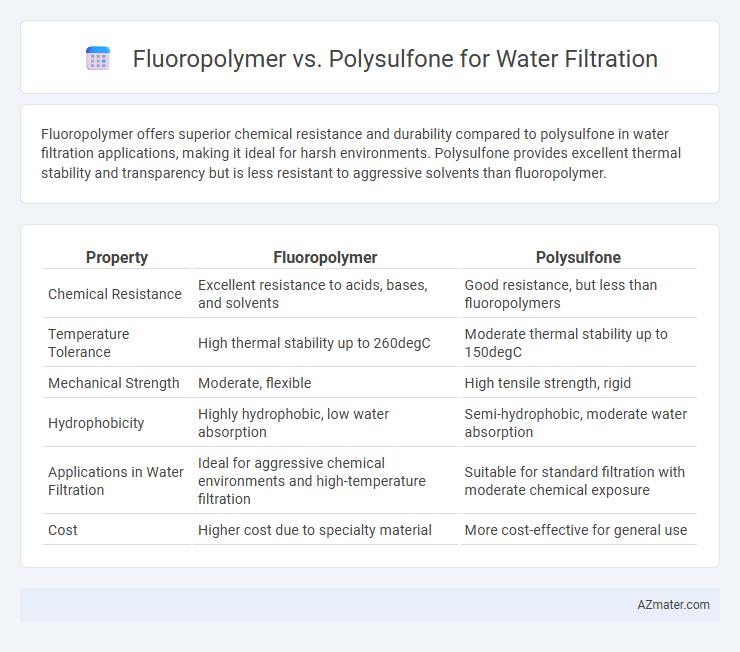Fluoropolymer offers superior chemical resistance and durability compared to polysulfone in water filtration applications, making it ideal for harsh environments. Polysulfone provides excellent thermal stability and transparency but is less resistant to aggressive solvents than fluoropolymer.
Table of Comparison
| Property | Fluoropolymer | Polysulfone |
|---|---|---|
| Chemical Resistance | Excellent resistance to acids, bases, and solvents | Good resistance, but less than fluoropolymers |
| Temperature Tolerance | High thermal stability up to 260degC | Moderate thermal stability up to 150degC |
| Mechanical Strength | Moderate, flexible | High tensile strength, rigid |
| Hydrophobicity | Highly hydrophobic, low water absorption | Semi-hydrophobic, moderate water absorption |
| Applications in Water Filtration | Ideal for aggressive chemical environments and high-temperature filtration | Suitable for standard filtration with moderate chemical exposure |
| Cost | Higher cost due to specialty material | More cost-effective for general use |
Introduction to Water Filtration Membranes
Water filtration membranes play a critical role in separating contaminants from water, enhancing purity and safety for consumption or industrial use. Fluoropolymer membranes offer exceptional chemical resistance and thermal stability, making them suitable for harsh environments and aggressive solvents. Polysulfone membranes provide high mechanical strength and excellent filtration performance, particularly in microfiltration and ultrafiltration processes, ideal for water purification and wastewater treatment applications.
Overview of Fluoropolymer Materials
Fluoropolymer materials, such as PTFE and PVDF, offer exceptional chemical resistance, high thermal stability, and low surface energy, making them ideal for water filtration applications exposed to harsh conditions. Their non-reactive nature and strong hydrophobic properties prevent fouling and contamination, enhancing filter lifespan and performance. These polymers maintain structural integrity under extreme pH levels and temperature fluctuations, outperforming polysulfone in durability and chemical compatibility.
Understanding Polysulfone in Filtration
Polysulfone is a high-performance thermoplastic known for its excellent chemical resistance, thermal stability, and mechanical strength, making it ideal for water filtration membranes and housing components. It offers superior resistance to chlorinated water and maintains structural integrity in high-temperature applications, ensuring long-lasting filtration efficiency. Polysulfone's hydrophobic nature also promotes efficient filtration by reducing fouling and facilitating easier cleaning compared to other polymer materials.
Key Differences in Chemical Resistance
Fluoropolymers exhibit exceptional chemical resistance against a broad range of aggressive solvents, acids, and bases, making them ideal for highly corrosive water filtration environments. Polysulfones, while offering good chemical stability and resistance to moderately acidic and alkaline conditions, are less resistant to strong oxidizing agents and certain organic solvents. This distinct difference in chemical resilience impacts their suitability, with fluoropolymers preferred for extreme pH conditions and polysulfones suitable for general water filtration applications with mild to moderate chemical exposure.
Filtration Efficiency Comparison
Fluoropolymers exhibit superior filtration efficiency over polysulfones due to their exceptional chemical resistance and hydrophobic properties, which minimize fouling and extend membrane lifespan. Polysulfone membranes generally offer good mechanical strength and thermal stability but tend to have lower resistance to aggressive chemicals, resulting in reduced durability and filtration performance in harsh water treatment environments. Studies indicate that fluoropolymer membranes maintain higher contaminant rejection rates and consistent flow rates, especially in applications involving aggressive solvents or extreme pH conditions.
Durability and Lifespan of Each Material
Fluoropolymers exhibit exceptional chemical resistance and thermal stability, making them highly durable for long-term water filtration applications, often lasting over 10 years without significant degradation. Polysulfone offers moderate durability with good mechanical strength and thermal resistance but tends to have a shorter lifespan, typically around 3 to 5 years in similar conditions due to its susceptibility to hydrolytic degradation. The superior chemical inertness of fluoropolymers ensures extended operational life and reduced maintenance compared to polysulfone.
Cost Analysis: Fluoropolymer vs Polysulfone
Fluoropolymer membranes generally incur higher initial costs than polysulfone due to advanced chemical resistance and temperature stability. Polysulfone offers a more cost-effective solution with moderate durability suitable for standard water filtration applications, balancing performance and budget. Long-term operational costs favor fluoropolymers in harsh environments by reducing maintenance and replacement frequency.
Applications in Industrial Water Treatment
Fluoropolymers exhibit exceptional chemical resistance and high thermal stability, making them ideal for aggressive industrial water treatment processes involving harsh chemicals and elevated temperatures. Polysulfone offers excellent mechanical strength and hydrolytic stability, suitable for filtration systems requiring long service life under moderate temperature and pH conditions. Industrial applications often favor fluoropolymers for acidic or oxidative environments, while polysulfone is preferred for general filtration tasks demanding durability and cost-effectiveness.
Environmental Impact and Sustainability
Fluoropolymers in water filtration offer exceptional chemical resistance and durability but pose environmental challenges due to their persistence and difficulty in recycling, contributing to long-term pollution. Polysulfone, though less chemically resistant, is more environmentally sustainable because it is easier to recycle and has a lower ecological footprint during production. Choosing polysulfone over fluoropolymers can reduce microplastic contamination and support water filtration systems that align with sustainable waste management practices.
Selecting the Optimal Membrane for Your Needs
Fluoropolymer membranes offer exceptional chemical resistance and thermal stability, making them ideal for aggressive water filtration environments involving harsh solvents or extreme pH levels. Polysulfone membranes provide superior mechanical strength and hydraulic performance, suitable for municipal and industrial water treatment with moderate chemical exposure. Selecting the optimal membrane depends on balancing chemical compatibility, temperature tolerance, and filtration efficiency based on the specific water quality and application requirements.

Infographic: Fluoropolymer vs Polysulfone for Water Filtration
 azmater.com
azmater.com